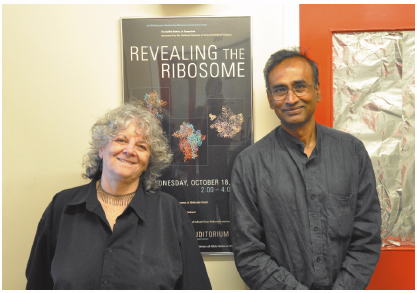- Home
- Users & Science
- Scientific Documentation
- ESRF Highlights
- ESRF Highlights 2009
- Structural biology
Structural biology
2009 has been an extremely productive and successful year for the Structural Biology Group and the scientific community that uses the ESRF’s facilities. No doubt the highlight has been the award of the Nobel Prize for Chemistry to Ada Yonath, from the Weizmann Institute (Israel) and Venkatraman Ramakrishnan, of the MRC Laboratory of Molecular Biology in Cambridge (UK), both of whom are long-term users of the ESRF. They share the prize with Thomas Steitz, from Yale University. As well as being regular users of the MX beamlines, these scientists, their groups and the projects they bring with them have contributed extensively to the increased automation and sophistication of the beamlines.
The conversion of beamline ID14-3 to a protein solution scattering beamline is almost complete. The beamline is operated as a collaboration between the ESRF and the EMBL Grenoble outstation and was officially inaugurated during the Council meeting in June 2009. Through a trilateral collaboration between the ESRF and both Grenoble and Hamburg EMBL outstations, equipment has been developed which, it is hoped, will enable higher throughput and increased reliability. Whilst still in its prototype stage, the liquid handling robot has proved a great success with the users of this beamline. Articles from the beamline are now reaching the publication stage and the very first results are reported here. Access to complementary facilities for protein solution scattering continues to be improved. We have completed the first stages of setting up a joint application procedure for small-angle neutron scattering (ILL) and X-ray scattering (ESRF) experiments.
The highlights presented in this chapter demonstrate the increasing complexity, medical relevance and impact of structural biology research undertaken at the ESRF. The articles cover a wide range of current research and demonstrate the ongoing vitality and pertinence of the field. The first steps towards regenerating the ESRF Structural Biology programme will start in 2010 with the construction of the (eventual) replacement for ID14, beamline ID30. This new beamline will further develop the sophistication and automation of the elusive hunt for crystals that diffract. We confidently expect that this facility will ultimately provide a paradigm shift in the prosecution of structural biology using synchrotron radiation. We look forward to an exciting 2010.
G. Leonard
 |
|
A. Yonath and V. Ramakrishnan outside the latter’s lab at the MRC Laboratory of Molecular Biology in Cambridge, September 2009 (Photo courtesy of M. Schmeing). |



